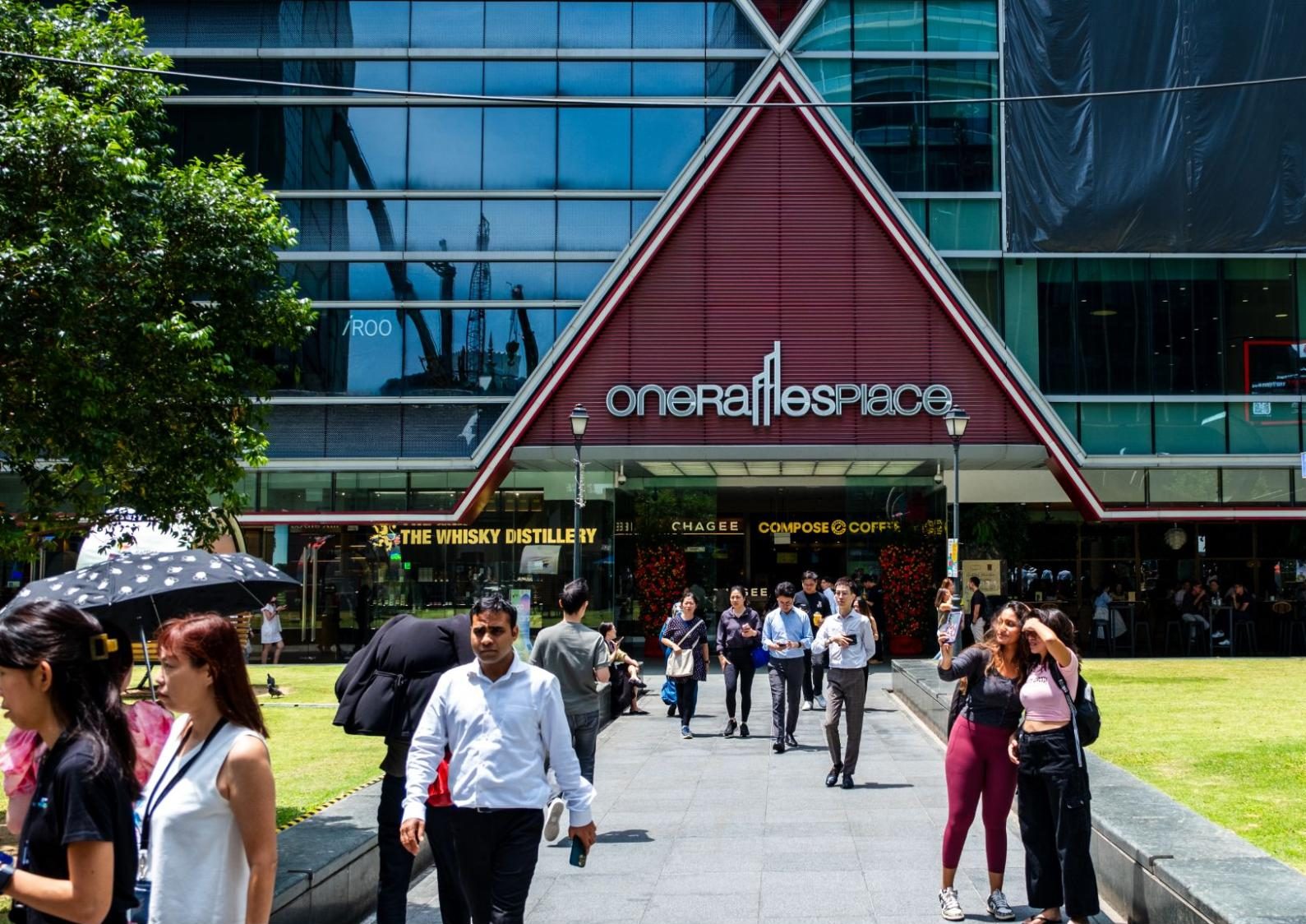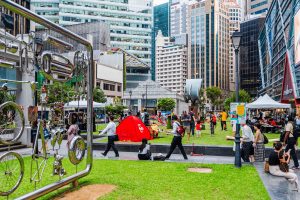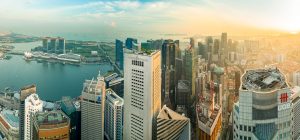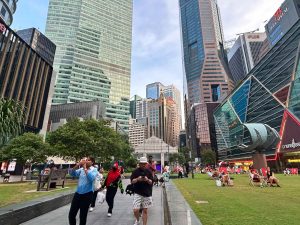Whether a first-time visitor to the Central Buzz District or a resident explorer, Raffles Place offers an eclectic mix of things to see, taste and experience, all just a hop, skip and a jump from Raffles Place MRT station. Many historical landmarks can be discovered and remembered around the vicinity, including Singapore’s oldest banks, department stores, bridges and temples, so let’s rewind the clock as we take a step back in time.
Raffles Place Park

Image credit: Remember Singapore
Originally called Commercial Square, Raffles Place started out as Singapore’s earliest commercial centre, a waypoint for traders all over the world to congregate.
The Raffles Town Plan, which was drawn up in the 1820s by Lieutenant Philip Jackson and Sir Stamford Raffles, serves as the earliest extant plan for Raffles’ envisionment of Raffles Place. Included in this Plan were the design guidelines for the new buildings, shophouses and streets, which became a blueprint for the urban development of the country.
Raffles Place eventually became home to some of the earliest established banks, namely Oriental Bank of London, Chartered Mercantile Bank of India and China, Chartered Bank of India, Australia and China, and Asiatic Banking Corporation.
In addition, Singapore’s oldest department stores like Robinson’s and John Little used to occupy the spaces where One Raffles Place and Singapore Land Tower presently stand.

Image credit: Remember Singapore
In 1997, the National Heritage Board declared Raffles Place a historical site. To this day, it remains a vibrant financial district for the working community.
Approximate walking time (from Raffles Place MRT): Less than 1 minute
Cavenagh Bridge

Plenty of Singapore’s oldest attractions are within walking distance from Raffles Place. You can track down the oldest bridge in Singapore by walking through the 24-hour linkway at Six Battery Road, where you’ll find Cavanagh Bridge on the right side.
Spanning across the Singapore river, this 156 year old bridge is remarkably one of the first suspension bridges in the region and the oldest bridge that remains in its original state. Designed in Scotland, the Glasgow-made steel structures were shipped to Singapore in parts and reassembled in 1869, serving as the last major construction carried out by Indian convicts.
In 2019, Cavenagh Bridge was officially gazetted a National Monument, alongside Elgin Bridge, and Anderson Bridge.
Approximate walking time (from Raffles Place MRT): 5 minutes
Yueh Hai Ching Temple

Just steps away from the Royal Group Building lies Singapore’s oldest Taoist temple, Yueh Hai Ching Temple.
Called Wak Hai Cheng Bio in Teochew, its name translates to “Temple of the Calm Sea built by the Guangdong People”.
The initial structure that was constructed by Chinese immigrants in the 1820s comprised a small makeshift shrine of wood and attap. It became a place of worship for these Teochew seafarers and merchants, who, after surviving the long arduous voyages from China to Singapore, would stop by to offer prayers in thanksgiving to Mazu, Goddess of the Seas.
Now revered for its matchmaking prospects, romantics frequent this sacred spot to call on Yue Lao, God of marriage and love in the hopes of finding themselves true love.
Approximate walking time (from Raffles Place MRT): 4 minutes
Lau Pa Sat

Image credit: The Straits Times
Raffles Place is home to many food gems. A favourite pitstop for local hawker flavours, this Victorian structure at Raffles Quay was the first ever market in Singapore back in 1824 (and now the oldest). It was positioned near the waterfront and fashioned out of timber and attap but in subsequent years got replaced with concrete, then cast iron.
Walk towards Boon Tat Street from Raffles Place MRT Exit I or J where, just opposite the road from CapitaGreen, you’ll come face-to-face with the market and its open-air ‘Satay Street’, the largest in Singapore.
Approximate walking time (from Raffles Place MRT): 6 minutes
Boat Quay

Another place steeped in history is Boat Quay, which was once the epicentre of trade along the Singapore River.
The decades-old godowns and shophouses that line the river now contribute to its unique charm, transforming Boat Quay into a lively spot for its nightlife culture. Hop onto a bumboat for a scenic ride along the river, offering a charming glimpse into Singapore’s maritime past.
You can get to Boat Quay from One Raffles Place Tower 2, by crossing Chulia Street and steering towards the waterway.
Approximate walking time (from Raffles Place MRT): 5 minutes
Fullerton Hotel

Image credit: The Fullerton Hotel
After a night’s gallivanting, it’s time to retreat from the hustle and bustle. Journey past Singapore Land Tower towards the Fullerton Hotel, where you’ll be stunned by its grandiose neoclassical architecture.
Opened as a 400-room heritage hotel in 2001, this now National Monument used to function as the General Post Office and has, over the years, housed the Exchange, the Chamber of Commerce, and the Singapore Club.
Between 1942 and 1945, the building was repurposed for World War II and had operated temporarily as a hospital, a bomb shelter, and the Japanese Military Administration’s headquarters.
Approximate walking time (from Raffles Place MRT): 5 minutes

So, if you’re a history lover looking to delve into Singapore’s storied past, add Raffles Place to your list of must-see places. With many heritage sites being in close proximity, a trip to Raffles Place is a terrific way to soak in its lasting legacy.




